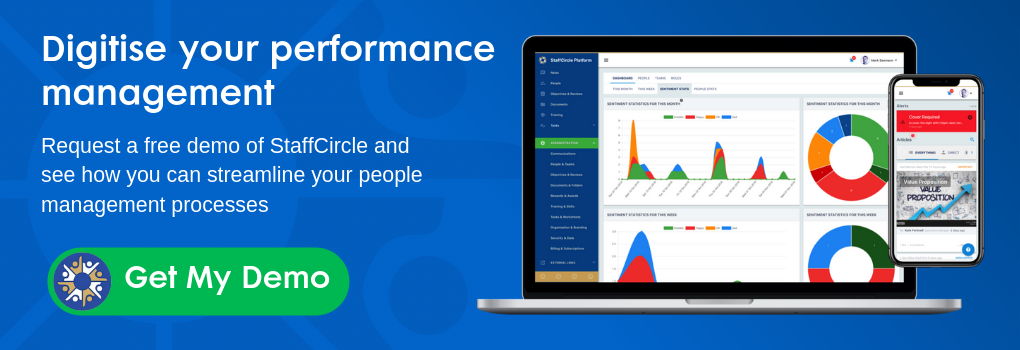Asking your managers to get the most from their teams should be straightforward, right? All they have to do is provide the right direction, set clear goals and hold regular meetings, yes? Well no, there’s a lot more to it. Enabling your workforce’s performance to skyrocket requires continuous communication and feedback and both employee and line manager need to see progress towards targets at any time. This means a paper system does not work. Only a digital performance management system will do.
But when a paper system costs a business “nothing” to upkeep because new documents can be created at any time and storage already exists, it may seem hard to build a case for spending thousands to go digital. Well here’s ours. Complete with costs.
Time investment
First of all, a paper-based performance management system does not cost a business nothing. It’s a significant investment in time for line managers who need to spend hours finding notes from previous line management meetings, checking through emails and other notes to check progress and then preparing appraisal documentation. And that’s all before the meeting has even started! Then there’s the meeting itself, and the note-taking and sharing of talking points after the meeting too. For each and every employee.
In fact, according to a study by CEB, the average manager spends about 210 hours (almost five weeks) doing appraisals each year. Just appraisals.
Given that it’s widely recognised that appraisals alone do not ensure high performance all year round – and that continuous feedback loops are required – one can only imagine how much time is needed to make this happen with a paper system. These line managers have day jobs too. Which areas of the business will suffer if they can’t get their own work done?
If we assume that the average company has 20 line managers, at annual salaries of £50,000 (or £26 per hour), then losing 210 hours each per year to appraisals means that the company is losing £109,200 every year on output. That’s the equivalent of 2 senior members of staff.
A digital performance management system ensures that info is recorded quickly. Plus it’s possible to add in quick updates from wherever you are at any point in the year. This means the prep work for the next appraisal takes minutes because all the information you need on the employee is analysed and presented to you on the system ready for you to use.
This means that the “cost” is not only far lower but the effort is being put to good use as the employee can track progress and will be more likely to meet/exceed targets.
Staff productivity
When an employee knows that their work is being monitored almost constantly and that there are consequences, both good and bad, for how they perform, you get good results and commitment. The employee wants to work hard to be rewarded/praised/recognised and they can see the system works.
Conversely, if promises for good work aren’t always followed through (because notes aren’t recorded properly or miscommunicated), or if the odd bad behaviour or slippage in work isn’t picked up, then employees won’t give you their best. This then spreads with reduced hours as staff start later and leave earlier, on the understanding that no one will notice (or care). And soon, everyone is doing it.
So with reduced hours, low productivity and low performance, you could see a dramatic decline in output. Using the same example as above, if a company has 400 employees, and each contributes an average of £80,000 in output for the business each year, and we assume a 30% drop in effort and performance, then this means a cost to the business of £9.6m each year.

Staff turnover
Who wants to stick around at a company where good work isn’t rewarded and performance management isn’t taken seriously? That’s the impression a paper-based system will give your employees and they’ll become disengaged.
According to research, over half (54%) of disengaged employees will consider leaving and every person that leaves costs a business an average of £30,614. This “cost” is based on the dip in productivity while the person leaving works their notice, recruitment fees to replace them, onboarding and training costs to get the new team member up to speed plus any drop in revenue caused by a gap in resourcing.
So, as before, if you have 400 people in your workforce. If half of them are disengaged and 54% of them leave in the next year, that’s 216 x £30,614 = £6.6million in costs to your business per year.
In total, for our example business, the paper system is costing them each year:
– £109,000 in lost time
– £9,600,000 in reduced staff productivity
– £6,600,000 in turnover costs
This is a total of £16,309,000 each year.
The digital performance management system
By digitising how you manage performance at your company, you’ll be able to keep a close eye on every employee, not only reassuring them that you care and good/bad work won’t go unnoticed but also making sure targets aren’t missed.
Not only that but digital performance management systems, like StaffCircle, make recording, managing and viewing employee performance a breeze. Time is saved, employees work hard, and they stick around too.
The other important point is that the system can be used across your business to improve communications too. From instant urgent alerts to monthly company updates, all can be shared with every employee on any device, keeping people connected and on track at all times.
This suddenly makes an investment of tens of thousands of pounds very worthwhile, doesn’t it?
Schedule a free demo today and save your business millions.






